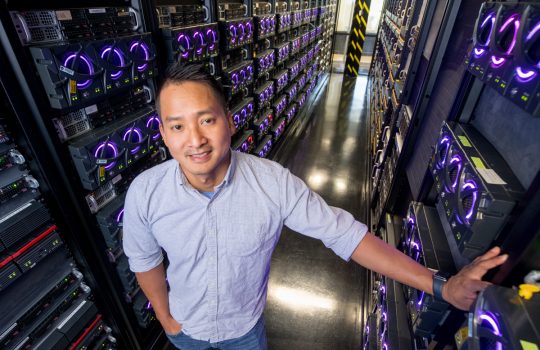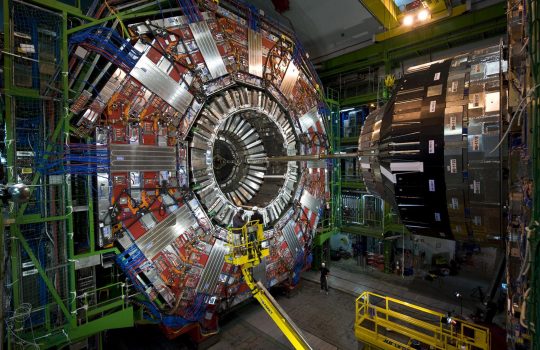BATAVIA, Illinois–Officials at the Department of Energy’s Fermi National Accelerator Laboratory today (Thursday) announced a potential five-hundredfold increase in the laboratory’s computer network connections to U.S. and international science communities. A new high-performance optical fiber link will connect Fermilab with one of the most advanced optical networking facilities in the world–the Science Technology And Research Light-Illuminated Gigabit High-Performance Transit facility on the Chicago campus of Northwestern University.
StarLight is a high-performance network exchange for many worldwide research and educational wide-area networks. A 92-kilometer optical fiber connects Fermilab, a particle physics laboratory located in Chicago’s western suburbs, with the StarLight facility, enhancing Fermilab’s high-speed connectivity with universities and institutions in North and South America, Europe and Asia. Such advanced networks are necessary in the global field of particle physics–scientists from 31 countries currently collaborate on Fermilab experiments.
“Fermilab’s connection to StarLight will greatly expand our opportunities to work with our university and laboratory partners,” said Don Petravick, Head of the Computation and Communications Fabric Department of Fermilab’s Computing Division. “Fermilab already has several petabytes–several quadrillion bytes–of particle physics data, and will host even more in the coming years. This new connection will allow interested scientists anywhere in the world access to that data in different and more efficient ways.”
The connection to StarLight will enhance Fermilab’s ability to conduct research in computer science as well as particle physics. The laboratory plays a leading role in developing data grid software that will enable experiments to distribute data worldwide.
“This cutting-edge technology is important for the national science program,” said Jane Monhart, director of the DOE’s Fermi Area Office. “The ability of worldwide research institutions to connect at high speeds through hubs such as StarLight is an important step in the next phase of national and international research.”
The new optical fiber connection has the potential to improve Fermilab’s computer network connectivity, currently provided by the DOE’s Energy Sciences Network at 622 megabits per second, to 330 gigabits per second. The connection follows the ESnet roadmap for connecting Fermilab, Argonne National Laboratory and StarLight in a high-bandwidth Metropolitan Area Network that also connects to ESnet. Thousands of DOE scientists and collaborators worldwide are linked by the ESnet high-speed network.
“I am delighted that Fermilab has been able to achieve this new and very significant connectivity to Starlight,” said ESnet Manager Bill Johnston. “This is an important milestone in the DOE Science Networking Roadmap that will provide Fermilab with high-speed and fail-safe connectivity to the ESnet core as well as to the international networks at StarLight.”
Among the networks that connect through StarLight are: I-WIRE, a state-wide advanced research optical network; LHCNet, a DOE funded link to CERN for LHC large scale science; CA*net4, which connects Chicago with all major Canadian universities and research institutions; Abilene, which connects universities and research laboratories across the U.S.; the DOE UltraScience Net; and the National Lambda Rail, a cross-country fiber-optic infrastructure for research and experimentation in networking technologies and applications.
“The StarLight community is pleased that Fermilab has joined us as a partner in creating the next generation of U.S. and international advanced networking,” said Joel Mambretti, Director of the International Center for Advanced Internet Research at Northwestern University, which develops and manages StarLight in partnership with the University of Illinois at Chicago, Argonne National Laboratory and major international networks.
Fermilab will initially link with its research partners through StarLight at 10 gigabits per second–16 times its current rate. This new link with researchers around the world will be required for upcoming particle physics experiments such as those at the Large Hadron Collider at CERN in Geneva, Switzerland.
“The first likely application will be through our new high-speed link to the UKLight research network,” said Petravick. “We will be able to share data from current Fermilab experiments with our university collaborators in the United Kingdom at an incredible rate.”
Fermilab is a national laboratory funded by the Office of Science of the U.S. Department of Energy, operated by Universities Research Association, Inc.
StarLight is developed and managed by the Electronic Visualization Laboratory at the University of Illinois at Chicago, iCAIR at Northwestern University, and the Mathematics and Computer Science Division at Argonne National Laboratory, in partnership with Canada’s CANARIE and Holland’s SURFnet. StarLight is made possible by major funding from the US National Science Foundation to the University of Illinois at Chicago and Department of Energy funding to Argonne National Laboratory. StarLight is a service mark of the Board of Trustees of the University of Illinois.



